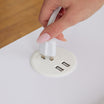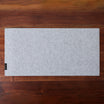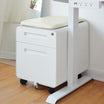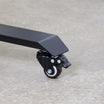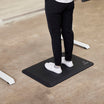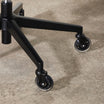What is burnout?
Let’s start with the basics. The term “burnout” was first coined in the ‘70s by Herbert Freundenberger and Christina Maslach two psychologists who independently studied this phenomenon on social service and health workers. They specifically targeted them due to the high volume of human interaction and chronic stress experienced on a daily basis.
To put it in Dr. Maslach’s words:
Burnout is a psychological syndrome of emotional exhaustion, depersonalization, and reduced personal accomplishments that can occur among individuals who work with other people in some capacity.
How to identify job burnout?
Burnout just doesn’t show up overnight. It builds itself gradually with every task, every project, every small favor that you half-heartedly accept in spite of your current workload, health, and values.
Sure, you can overcommit and put in 3 more hours to finish an important project. But it will catch up sooner or later, making you wonder how did you put on weight or why is everybody avoiding an overachiever like yourself.
In fact, a recent Galup study on 7.500 full-time employees reported that 23% often felt burned out or always at work, while an additional 44% felt burned out sometimes. The same study concluded that out of this batch, 28% of millennials experienced frequent levels of burnout compared to 21% of the older generation, while only 45% felt it sometimes. That’s 7 out of 10 millennials. Remember this next time you want to blame this generation about your problems 😉

To make sure you don’t pull the smaller stick, diagnose yourself first. Sit down and think about all the situations that made or make you feel exhausted, anxious, or furious. It may be something like a nagging manager, the narrow deadlines that you need to hit on a consistent basis, or the coffee machine which is always dirty. It doesn’t matter. Your goal here is to identify the root cause of burnout.
Use a design research technique like the 5 Whys or keep a stress diary to evaluate the time of the day, intensity, duration, situation, triggering events, and reactions that occur during burnout, like in this template
There’s also a Burnout Self-Test to check your level of stress on a 15-75 point scale that only takes a few minutes.
Once correctly diagnosed, it’s time to protect yourself from it.
How to recover from burnout
When it comes to job burnout, the hardest part is breaking out of it.
“But you don’t get me, Marcel, I have so many things to do and there’s no one in my team who can actually do this right now besides me!”
While I don’t deny that, neglecting yourself all too often comes at the expense of your health and social life. Apart the most common sense advice like sleeping for 8-9 hours each day in a pitch black room, exercising regularly, and eating healthy food, here are 5 steps on how to recover from burnout:
1. Take regular breaks
Our brains are not engineered to sustain extended periods of attention. That’s why focusing too long on a task can actually decrease the motivation and performance needed to complete it, according to this study.
The antidote is to have short interruptions (a.k.a. breaks) throughout the day: leg stretches, calls with your loved ones, walks in the park, you name it. Basically, anything that moves you away from the computer and allows you to regroup your mind. Don’t shy away from taking vacations as well, especially after a large, stressful project – provided that you have other similar ones lining up around the corner.
2. Control your devices
On average, people check their phones 150 times a day. Yes, you read that right, there’s no typo. Although this compulsive behavior is seen as a way to cope with stress and keep yourself up-to-date, it only creates a state of FOMO (fear of missing out).

To take charge of your day, turn off notifications or your devices altogether at work. A much lighter version of control is to uninstall all apps on your phone that have infinite scroll, like Facebook, Instagram, and LinkedIn. Or use tools that temporarily disable notifications and block certain websites, the choice is yours.
3. Learn to say no
When you recover from severe burnout, don’t take on any additional work or projects. Yes, there will still be chores and people who depend on you. But trust me, you already have your plate full and can do so many things at a time
If you want to be at the top of your game and achieve excellence (not perfection), think in terms of momentum. Of what does it take to sustained long-term results. Otherwise, you’ll crash and burn after each major project because you didn’t respect your boundaries. Brendon Burchard put it best when he said:
Set yourself up for excellence not exhaustion, for excellence not mediocre, for excellence, for something you can have pride about, something you can feel good about inside.
Talk to your boss or manager about dropping off tasks and projects that are not urgent, or try to delegate some of your responsibilities to your colleagues – even when you know they’re not going to carry them out the way you would.
4. Rely on job burnout recovery strategies
Do you often think that you can do so much in a day then barely manage to finish half of your to-do list?
Happens to me too, no worries. The solution here is to know how much time it takes to complete a task, then figure out how many you can do in a day. Sounds easy, right?
Wrong. Estimating tasks is more art than science, requiring considerate practice before getting a grip of it. There are strategies though you can rely on to make sure nothing falls through the cracks while you work only on the tasks that matter. Here’s a few of them:
- Prioritize tasks. Know what to work on first and in which order by setting up task priorities. These can be either time or urgency based, but for something more complex, go for the Eisenhower Decision Matrix which identifies four different priority buckets (urgent/not urgent/important/not important) and gives further action steps for each one.

- Delegate. This is worth mentioning again. Outsource as many things as possible, up until you arrive at the tasks that only concern yourself, are actionable, and take more than 2 minutes to complete, as the popular productivity method Gettings Things Done (GTD) recommends.
5. Consider a support group
In a more recent study, Dr. Maslach has found out that the best way to heal burnout is human connection. To put it in her words:
That social network, that each of you have each other’s back, that they’re there for you and you’re there for them, that’s like money in the bank. That’s a precious, precious resource.
So look out for mentors and professionals who can support you in your career and shine a bit of light on the problems that you’re currently facing. Find them in your company or in industry-specific organizations, like the Project Management Institute (PMI®), that organize open platforms and events for people to come together, interact, and exchange ideas.
You could also bond with people outside work by joining different hobby classes, volunteering, or attending local meetups. If you’re still uncomfortable with meeting new people, then resort to your family’s support. After all, they’re the ones who know you for better or worse. The whole idea is to share your feelings and create meaningful, positive relationships, which reduce the isolation that often comes with job burnout.
Looking at the glass half full
Burnout might feel like an inescapable burden at first. The chances are that you’re still going to experience it at one point in your career, if not several times, especially if you’re a leader or successful professional.
In addition to the strategies we’ve laid out so far, understand the silver lining behind job burnout. This might be the perfect chance to reassess your goals, dreams, and values. To test a few assumptions that you took for granted.
Who knows? Perhaps you’ve done too much overtime in the hope that you’re going to jumpstart your career. As a result, you have little to no time to enjoy life – the classical “Work to Live” versus “Live to Work” debate. Or maybe you’ve put too much effort into building an online persona that is completely different from the real you.
That’s why next time burnout hits, take a step back to rediscover yourself again.











